We are pleased to announce the launch of a new personal blog by Jean-Michel Cazes.
We hope you enjoy the read.
Stay well, stay safe.
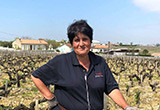
We are pleased to announce the launch of a new personal blog by Jean-Michel Cazes.
We hope you enjoy the read.
Stay well, stay safe.
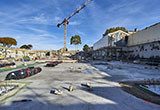
The project to renovate the technical installations at Lynch-Bages is coming along nicely under the supervision of Chien Chung (Didi) Pei and Bordeaux architect Arnaud Boulain...
A year after work commenced, the foundations and underground structures of the future fermenting room are beginning to take shape.

Didi Pei and Jean-Michel Cazes
30 years after they first met on the Louvre Pyramid construction site.
The renovation of our wine cellars and fermenting rooms began in early 2017 and should last another 18 months, with completion scheduled for the second half of 2019.
A look back at the key stages of the project
Arnaud Boulain, principal at "BPM Architectes" the contractor company, is in charge of the execution and the coordination of the project. We asked him how the work is progressing:
« The project started in late January 2017 with the selection of partners to create the workshop drawings. These drawings were then compared and contrasted so that the technical and architectural components could be assembled and adjusted, a little like the pieces in a jigsaw.
The short and intense ‘deconstruction phase’ took place from April to June 2017.
Construction got underway in May 2017. We began by building a system of underground perimeter walls (diaphragm walls) to strengthen the works area and keep the earth around it in place while we excavated the future foundations.
We have now finished building the foundations and are erecting pillars in decorative architectural concrete to support the floor of the future fermenting room. »
The weather was good in 2017, so the deconstruction phase and work on the foundations progressed quickly. But there was a lot of rain at the start of 2018 which slowed things down..
« To make up for the delay caused by bad weather in the new year, and to meet delivery requirements, the work is being carried out in two successive eight-hour shifts each day. »
BPM Architectes are working with Pei Partnership Architects, who are headquartered in New York.
The team of architects and engineers is a mix of generations and nationalities, with people from the USA, China, Mexico, Chile and France – just like in the Médoc…
« Despite the eight-hour time difference separating our teams, our working relationship with Didi Pei and Project Director Rossana Gutiérrez is excellent. Thanks to Didi’s great human qualities and availability, the project is moving forward smoothly and swiftly. »

In the foreground from left to right, Jean-Michel Cazes, Jean-Charles Cazes, Didi Pei, Arnaud Boulain and Rossana Gutiérrez visiting the building site in January .
A functional building designed exclusively around wine and wine production
The construction project and associated works are the logical outcome of a detailed study of our vineyard, its plots and their preservation. This renovation of our vinification facilities is the culmination of several decades of work.
We will have a new dedicated harvest reception area, a made-to-measure fermenting room enabling precise, plot-by-plot vinification, and a larger wine cellar so that we can mature two vintages at the same time and optimise and adjust our maturation periods.
The project will provide Lynch-Bages with a functional building designed exclusively around wine and wine production, while allowing us to safeguard our savoir-faire and at the same time pursue our modernisation agenda!

Our neighbours in Bages are keeping a watchful eye on the work...
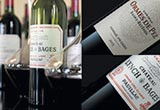

Dear friends from Canada and US,
You are not able to come visit us at Lynch Bages? We are coming to see you and bring you a taste of our fabulous 2015 vintage!
Come find us at the 2015 vintage tasting in your City.
Kinou Cazes-Hachemian will be pouring the latest released vintage of Château Lynch-Bages and Ormes de Pez in:
Click here for more information
We look forward welcoming you during one of our tastings dedicated to trade and consumer!
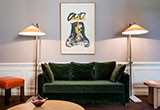
In 1989, Jean-Michel Cazes, owner of Château Lynch-Bages and a contemporary art lover, was seeking a parallel to portray the finesse and elegance of his wine. When he discovered the works of Pierre Alechinsky, he asked him to depict this magnificent vintage.
And so "Lynch-Bages as seen by… Alechinsky" was born...
Since then, a succession of great artists has found inspiration in the diversity and subtlety of the wines of Lynch-Bages.
The passage of time has seen the creation of an outstanding collection of works of art: Jean Le Gac, Arroyo, Sandro Chia, Titus Carmel, Donald Lipski, Jiri Kolar, Tan Swie Hian, James Brown, Hervé Di Rosa, Günther Förg, Ryan Mendoza, Emilio Perez, Arnulf Rainer, Paul Rebeyrolle, and Antoni Tàpies…
Until Lynch-Bages launched its renovation project earlier this year, the whitewashed walls of the ancient vat-house provided the perfect backdrop for these exhibitions.
1989 was also a landmark year for Cordeillan-Bages, when they it became the only Relais & Châteaux in the Médoc. A veritable haven of peace incorporating gastronomy, wine and the world of culture: the core of the promotion of an “art de vivre” that the Cazes family wishes to share with visitors from all over the world..
A visit to Cordeillan-Bages offers the chance to admire works from exhibitions staged at Lynch-Bages in tandem with the Galerie Lelong in Paris.
In 2001, Lynch-Bages hosted the first Alechinsky exhibition titled "Mémoire volatile".
In 2014, Lynch-Bages offered its visitors a selection of important works by the artist
Pierre Alechinsky was born in Brussels in 1927. Whimsical and non-conformist, Alechinsky’s work is characterised by a freedom of inspiration and writing. His pictures are populated by strange beasts, creatures that are half-fantasy-half-naïve, or the odd plant. Gazing at his work, we discover to our delight that painting sometimes is a thing of magic…

Chicago (lithographie) - 1991

Mémoire volatile - 1990
“If I can’t change the world, at least I want to change the way people look at it” said the Catalan painter Antoni Tàpies… In 2002, Lynch-Bages had the great honor to present "Poetic of Things" an exhibition featuring his artworks with unconventional materials such as marble dust, ground chalk, sand and earth.

Vernis et collage - 1988

La cloche tibétaine (lithographie) - 1991
En 2003, Château Lynch-Bages welcomes a series of large format paintings of the artist on the occasion of an exhibition titled "Délassements & Génies" .
Jean Le Gac was born in 1936 in Alès in the Gard region of France. His recurrent theme - the tribulations of a painter - unfolds between fiction and confession, between painting and literature, at the junction of so-called minor genres. In this way, he renews the principle of illustration, the novelistic verve and images of serial novels.

Les grandes vacances ou le prisonnier - 1992

Le peintre nocturne - 1988-1990
In 2012, Lynch-Bages had the great pleasure of welcoming the dynamic compositions of abstract artist Emilio Perez in the cellars. A beautiful series of artworks influenced by the rythm of music and the movement of the ocean. An artwork full of energy that can be seen at the restaurant of Cordeillan-Bages.

Nowhere you've been - 2011
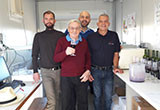

From left to right, Jérôme Leroux, Jean Cordeau, Nicolas Labenne and Franck Debrais
On a morning in October, a man walked among the vats. The last harvests had been received and the wines had begun fermenting. He shook the hand of most he met, his eyes sharp, his smile warm. Some called him Mr. Cordeau out of respect, but he'd rather you call him Jean. That October morning, he had come to talk of his past, of his history with Lynch-Bages and the Bordeaux vineyard, of the sixty vintages he has worked on. Read on to find out more about this man of passion.
His career began when barely 22, a young agricultural engineering graduate of the National School of Agriculture in Montpellier. He started his first job on 2 August 1958 as an agricultural consultant near Blaye, France. A new technical post created and tested by the Gironde Chamber of Agriculture. In 1970 he was appointed head of the Chamber’s vine department, and ten years later founded the laboratory for analysis and agronomic advice in Blanquefort which he managed for fifteen years.
With time, he became an expert in the vine and its behaviour. He even wrote a book on the subject.
Then came retirement, and Jean decided to bring his thirty-eight years at the Chamber of Agriculture to a close. But his passion lived on, a fact reflected in his activities, and he chose to launch his own business. Contacted by various different chateaux, he became a self-employed consultant.
In the space of ten years, and without even realising it, he gradually left his imprint throughout the Bordeaux vineyard.
Since 2006, he has been happy to share his lifetime of knowledge and know-how at no cost, on just two conditions: that he finds the mission interesting and that he likes the people he meets! Fortunately for us, Nicolas Labenne, Technical Director for Lynch-Bages, satisfies both criteria hands down. The two men share the same passions, for rugby and the vine, so when they work together their try is generally converted.
According to Jean Cordeau, Lynch-Bages enjoys particularly harmonious soils with different gravels, which create a great strength and finesse. He helped choose the strains used for the Petit Verdot plot. And readily admits that this grape variety is one of his favourites, because it produces tannic wines, both round and harmonious, never rough.
He is glad to lend a helping hand at Nicolas Labenne's request, in order help the vine along. You simply have to wander through the rows with him to realise that, at the age of eighty, he is familiar with every detail, a knowledge he is pleased to share with contagious enthusiasm. When asked what his favourite time of year is, he’ll say it’s when “I tremble at the same time as the vine”, in reference to bud break and flowering, crucial periods over which the risk of frost and coulure hang heavy. “And the harvest too”, which brings first predictions, “and when the vine is dormant”, for the pruning... like any enthusiast, he finds it hard to choose.
Although he began in the 1950s, when most of the vineyard was worked on horseback, he is not one to regret the past. According to him, Bordeaux wines have never been as good as they have in the past twenty years. “Before then, great vintages were almost an exception.” Although he would probably never say that, if they are better today it is also thanks to men like him.
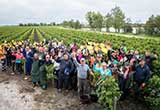

For the second year running, João Tito and his team of about 50 pickers travelled over 800 km from the city of Mirandela in northern Portugal to reach Pauillac, where our Lynch-Bages vineyards stretch over the land.
From a distance, you would have seen heads bent over rows of vines, backs hunching as baskets were filled, eyes trained on sorting tables. On approaching you would have heard laughter, the odd “cuidado!”, and maybe a song. A group of men and women ranging in age from 18 to 68, from different walks of life, brought together this year, during the period from18th September and 5th October, when harvest was finished.
In their hometown, they are plumbers, students, bricklayers, bakers and psychologists, some are retired.
In the vineyard they form an organised group sharing tasks, forty pickers filling the baskets of ten carriers, taking it in turns to pour their harvest out onto the sorting table.

It took just a few days for the pickers to get into the swing of things, under the watchful eye of Nelson Pires, reporting to vineyard manager Franck Debrais. Each morning he would check who was present, set the agenda for the day, assign every picker a row and keep morale high. Nearly all those present last year returned in 2017, some for the adventure and the journey, others for the more practical purpose of earning an additional wage, all revelling in the atmosphere and – they are the first to admit – in the gourmet French meals!

Most were recruited by João Tito, a bus driver by profession, who brought them from Mirandela all the way to Pauillac and who ferried them to and fro every day between the vineyards and the Le Paradis campsite where they were staying. It was he who put up posters throughout the town and who spread the word among friends and more distant acquaintances to attract volunteers, and it didn’t take him long to find his team, even managing to convince his 60-year-old father to join them.
Franck is delighted with how it all went. “We worked methodically and efficiently, respecting each other’s sensitivities, and in contagious good humour,” he said.
Although conscientious and committed, all admit that harvesting is a rapid source of aches and pains, but they lost neither their motivation nor their momentum. According to Deolinda, the eldest woman in the group, grape harvests are nothing compared to strawberry picking. And the 60-year-old should know what she’s talking about, because she harvests olives, strawberries, almonds and chestnuts all year round. Others speak of the need for common sense and for a little inside knowledge, for example adding small cushions to the baskets relieves the backs and shoulders of carriers.



This year again, all poured their energy into helping us with these first stages of our 2017 vintage. And when the harvest finally came to an end, we had just one wish... that we would see them all again next September!
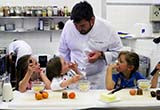

Junior Chef Cooking Classes with Chef Julien Lefebvre
It’s never too early to educate young palates and develop the desire to try new things!
Chef Julien Lefebvre opens his kitchen to children (6-12 years) during special cooking classes, a playful way to explore the joys of cooking, taste and develop the desire to try new things at home.
In the kitchen with the chef, they create a main course and a dessert, from a selection easy to reproduce at home.
Depending on the ages of the children and the chosen recipes, different themes will be covered: taste, mathematics, seasonality and culture, geography, plate dressing or safety in the kitchen.
The course is followed by a 30-minutes tasting.
In addition, young chefs enjoy access to Cordeillan-Bages outdoor swimming pool, before or after the workshop. A non-alcoholic fresh drink is offered, as well as a surprise gift !
Kids and parents welcome!
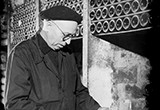

Roger Mau
Most Médoc cellars have been frequented at one time or another by cats. Their very presence was enough to keep rats and mice at bay. Lynch-Bages was no exception. At one time, cellar master Roger Mau jealously guarded a cat who had taken up residence in its cellars. We’d bump into him from time to time in one of the many hallways, where he used to prowl. He had no name, and simply became “Le chat de Monsieur Mau”. Every day he’d receive a plate of milk, served by the cellar master beneath the wooden vats in the fermentation cellar. Roger Mau assumed the task throughout the week. And he’d return to look after his cat at the weekend, when the cellars were otherwise deserted.
One Saturday morning, in 1975, Roger Mau made his way to the fermenting room as usual armed with his milk churn. No sooner had he entered the room than a smell attracted his attention. When he looked up, he could see smoke filtering through the slatted floor. It was coming from above. Mr Mau rushed up the stairs and saw flames reaching about twenty centimetres at the top of the sixth vat in the middle on the left, licking the top three feet of its upper section near the hatch. The cellar master wasted no time and filled a bucket with water from the nearby tap, easily extinguishing the fire just as it was beginning.
What had happened? The day before, he’d issued instructions to “sulphur” the vat. This involves burning a sulphur wick inside the vat to release sulphur dioxide, which acts as an antiseptic and disinfects the wood. Normally, the wick, which is attached to a 25-cm long wire hook, is hung at a reasonable distance from the vat wall, just like in barrels, in order to avoid any accidents. Because sulphur produces very small flames when it burns, there is a reasonably low risk of fire spreading over the wood. Unfortunately, the person who performed the task late Friday afternoon had hung the wire on the edge of the hatch closest to the wall. The incandescent wick was therefore in contact with the vat’s wooden staves throughout the night. Fortunately, the fire hadn’t started immediately but had been smouldering all night. When the wood finally caught fire, early Saturday morning, it coincided with the time when the cat usually took his breakfast.
Because there were no employees on the premises, which is quite normal for a Saturday, there is no doubt in anyone’s mind that if Roger Mau had not brought his cat his morning plate of milk the fire would have spread rapidly. And there would be nothing left of our historic Lynch-Bages fermentation cellar. It is even likely that the fire would have spread beyond the fermenting room, which at the time communicated directly with the barrel cellars and the chateau itself.
So in our new facilities we should be thinking of erecting a small monument in memory of "Le chat de Monsieur Mau"!
- Jean Michel-Cazes, 22 September 2017 -
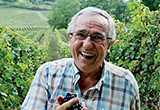

Head Winemaker Daniel LLose, oversees all the Cazes family estates
Leaving the post of non-commissioned army officer to become a winemaker doesn't appear as a straightfoward career move... Well think again, because this is precisely what Daniel LLose did in 1976.
We recently celebrated his 41st anniversary at Lynch-Bages. Daniel, as spontaneous as ever, accepted an interview to mark the occasion!
What is your first memory of Lynch-Bages?
I remember the “Boss” (Jean-Michel Cazes), of course, because he was the one who hired me!
And a duo, the Roger Mau/Gabriel Bérard tandem. Roger Mau, who must have already been in his seventies, was both technical director and cellar master. I was seriously impressed by his empirical knowledge. And by the way he always held his pipe in his mouth when tasting, whether it bothered anyone else or not! Gabriel Bérard was vineyard manager, he’d worked his way up through the ranks and would visit the 45 hectares of vineyards on his moped, because he’d never got round to getting a driving license!
If you had to pick three words to describe your job?
In addition to hard work (rather than “talent”), I’d say memory, observation and humility.
What do you find most stimulating?
The fact that there is no “copy and paste”, that and the perpetual renewal.
What do you like most about wine?
The conviviality it brings when those sitting around the bottle don’t spend too much time splitting hairs.
If you had to choose a vintage?
1982. It might not be the greatest, but it jogs some fantastic memories and is still a very good vintage today.
Your best tasting memory?
There are too many to name, it’s never easy choosing just one. But if I had to pick my first great tasting memory, I’d mention a wine that few people have heard of, vinified by Roger Mau and which no longer exists: Grand Vin des Rosiers 1929, a Pauillac AOC I tasted in the late 70s. At the time, I remember thinking it was a beautifully-balanced gustatory “legend”, radiating a particularly wonderful youth... From that moment on, and although a (highly) chauvinist Catalan, I knew I was working in a great terroir!
In your opinion, what makes Lynch-Bages different from the other Bordeaux Grands Crus?
It’s not for nothing that this Fifth Cru Classé is considered to be on a par with the Seconds! Lynch-Bages has a remarkably high-quality homogeneity thanks to its different soils. Its vineyard may not be associated with the leading Médoc terroir, but the entire parcel benefits from extremely “solid”, top-quality soils.
What have you learned in the forty years (and more) spent at Lynch-Bages?
“Now I know, I know that you never know,” as Jean Gabin would say.
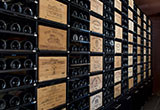

Chef Sommelier, Arnaux Le Saux
A native of Nantes, Arnaud Le Saux fell in love with wine while attending hotel management school.
« I did not know much about wine, I took an extra course on the topic, visited wineries, met producers, and never looked back ».
Since 2013, he is the head sommelier at Cordeillan-Bages. He designs the wine list for visitors who wish to discover the Bordeaux wine region.
With a wine-list of over 1,500 references, he offers Bordeaux Grands Crus, as well as a very fine collection of wines from elsewhere.
« I adapt to guests’ tastes, and always hold a selection of wines that I especially recommend. »
According to this wine lover, « a good wine is one that you want to savour again once you have finished your glass and a great wine produces a special emotion, and leaves a lasting impression ».
Attentive, always ready to explain wine in simple terms, and to talk to winemakers who he meets on a regular basis, Arnaud le Saux also creates food and wine matching in harmony with the Chef Julien Lefebvre: « A good food and wine match is based on balance. The wine must not alter the taste of the dish and the dish must not overpower the wine ».
Thanks to his expertise, the restaurant was selected finalist in the 2017 Tour des Cartes competition for the “Luxury Hotels and Michelin-starred Restaurants” category.